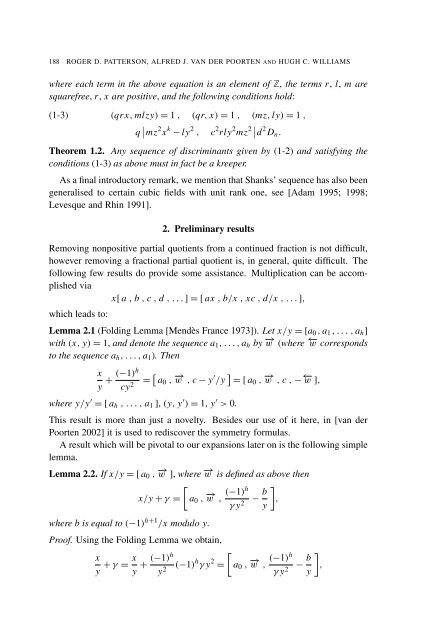Characterization of a generalized Shanks sequence - Department of ...
Characterization of a generalized Shanks sequence - Department of ...
Characterization of a generalized Shanks sequence - Department of ...
Create successful ePaper yourself
Turn your PDF publications into a flip-book with our unique Google optimized e-Paper software.
188 ROGER D. PATTERSON, ALFRED J. VAN DER POORTEN AND HUGH C. WILLIAMS<br />
where each term in the above equation is an element <strong>of</strong> , the terms r, l, m are<br />
squarefree, r, x are positive, and the following conditions hold:<br />
(1-3)<br />
(qr x, mlzy) = 1 , (qr, x) = 1 , (mz, ly) = 1 ,<br />
q mz 2 x k − ly 2 , c 2 rly 2 mz 2 d 2 Dn.<br />
Theorem 1.2. Any <strong>sequence</strong> <strong>of</strong> discriminants given by (1-2) and satisfying the<br />
conditions (1-3) as above must in fact be a kreeper.<br />
As a final introductory remark, we mention that <strong>Shanks</strong>’ <strong>sequence</strong> has also been<br />
generalised to certain cubic fields with unit rank one, see [Adam 1995; 1998;<br />
Levesque and Rhin 1991].<br />
2. Preliminary results<br />
Removing nonpositive partial quotients from a continued fraction is not difficult,<br />
however removing a fractional partial quotient is, in general, quite difficult. The<br />
following few results do provide some assistance. Multiplication can be accomplished<br />
via<br />
x[ a , b , c , d , . . . ] = [ ax , b/x , xc , d/x , . . . ],<br />
which leads to:<br />
Lemma 2.1 (Folding Lemma [Mendès France 1973]). Let x/y = [a0 , a1 , . . . , ah]<br />
with (x, y) = 1, and denote the <strong>sequence</strong> a1, . . . , ah by −→ w (where ←− w corresponds<br />
to the <strong>sequence</strong> ah, . . . , a1). Then<br />
x (−1)h<br />
+<br />
y cy2 = a0 , −→ w , c − y ′ /y = [ a0 , −→ w , c , − ←− w ],<br />
where y/y ′ = [ ah , . . . , a1 ], (y, y ′ ) = 1, y ′ > 0.<br />
This result is more than just a novelty. Besides our use <strong>of</strong> it here, in [van der<br />
Poorten 2002] it is used to rediscover the symmetry formulas.<br />
A result which will be pivotal to our expansions later on is the following simple<br />
lemma.<br />
Lemma 2.2. If x/y = [ a0 , −→ w ], where −→ w is defined as above then<br />
<br />
x/y + γ = a0 , −→ w , (−1)h<br />
<br />
b<br />
− ,<br />
γ y2 y<br />
where b is equal to (−1) h+1 /x modulo y.<br />
Pro<strong>of</strong>. Using the Folding Lemma we obtain,<br />
x x<br />
+ γ =<br />
y y<br />
(−1)h<br />
+<br />
y2 (−1) h γ y 2 =<br />
<br />
a0 , −→ w , (−1)h<br />
<br />
b<br />
− ,<br />
γ y2 y

















